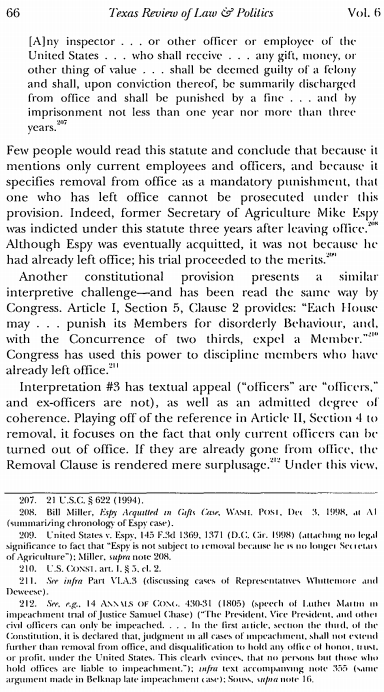The main reason that one sees so many tweets about the 25th Amendment (§4) is that so many people think it works like this:
Step 1: Someone invokes the 25th Amendment.
Step 2: The president is removed from office.
But it doesn't work like that.
1/6
Step 1: Someone invokes the 25th Amendment.
Step 2: The president is removed from office.
But it doesn't work like that.
1/6
First, it requires incapacity. Not impairment, ineptitude, or extreme badness. Full-on incapacity. That's a high bar.
Second, it's invoked by the VP and Cabinet. 25A's drafters thought they'd be reluctant to move against their boss. For the drafters, this was a plus.
2/6
Second, it's invoked by the VP and Cabinet. 25A's drafters thought they'd be reluctant to move against their boss. For the drafters, this was a plus.
2/6
(Don't say "25A is unavailable b/c the whole Cabinet is 'acting.'" Only 1 of the 15 is acting, and even if there were more it wouldn't pose a problem.)
Third, if 25A4 is invoked, the president isn't removed. He can come back—and 25A4 stacks the deck heavily in his favor.
3/6
Third, if 25A4 is invoked, the president isn't removed. He can come back—and 25A4 stacks the deck heavily in his favor.
3/6
In a contested case 25A4 requires more votes in Congress than impeachment/removal. If not enough folks want him gone to make impeachment work, 25A4 will fall even shorter.
In essence, 25A4 requires a big chunk of the president's backers to think that he's already gone.
4/6
In essence, 25A4 requires a big chunk of the president's backers to think that he's already gone.
4/6
Fourth, this means invoking 25A4 likely would only sideline a resistant president for a few days.
Now imagine what the aftermath of his return would look like.
The probable net effect of invoking 25A4 doesn't seem likely to please Trump opponents. It's not the right tool.
5/6
Now imagine what the aftermath of his return would look like.
The probable net effect of invoking 25A4 doesn't seem likely to please Trump opponents. It's not the right tool.
5/6
Bottom line: Any time a president is able to contest a 25A4 action, 25A4's design *protects* the president and makes it hard to push him aside. People who want to be rid of Trump would be better off seeking more fruitful avenues.
For more detail see: amazon.com/Unable-Politic…
6/6
For more detail see: amazon.com/Unable-Politic…
6/6
• • •
Missing some Tweet in this thread? You can try to
force a refresh






